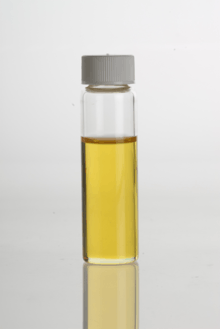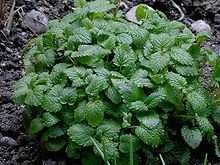Melissa officinalis
| Melissa officinalis Lemon balm | |
|---|---|
 | |
| Scientific classification | |
| Kingdom: | Plantae |
| (unranked): | Angiosperms |
| (unranked): | Eudicots |
| (unranked): | Asterids |
| Order: | Lamiales |
| Family: | Lamiaceae |
| Genus: | Melissa |
| Species: | M. officinalis |
| Binomial name | |
| Melissa officinalis L.[1] | |
Lemon balm (Melissa officinalis), also known as balm[2] or balm mint and not to be confused with bee balm (which is genus Monarda), is a perennial herb in the mint family Lamiaceae, native to center-southern Europe and the Mediterranean region.
It grows to 70–150 cm tall. The leaves have a gentle lemon scent, related to mint. During summer, small white flowers full of nectar appear. These attract bees, hence the genus name Melissa (Greek for 'honey bee'). Its flavour comes from citronellal (24%), geranial (16%), linalyl acetate (12%) and caryophyllene (12%).[citation needed]
Cultivation
In North America, Melissa officinalis has escaped cultivation and spread into the wild.[3]
Lemon balm requires light and at least 20 degrees Celsius (70 degrees Fahrenheit) to germinate.
Lemon balm grows in clumps and spreads vegetatively as well as by seed. In mild temperate zones, the stems of the plant die off at the start of the winter, but shoot up again in spring. Lemon Balm grows vigorously and should not be planted where it will spread into other plantings.
Melissa officinalis may be the "honey-leaf" (μελισσόφυλλον) mentioned by Theophrastus.[4] It was in the herbal garden of John Gerard, 1596.[5] There are many cultivars of Melissa officinalis, such as:
- M. officinalis 'Citronella'
- M. officinalis 'Lemonella'
- M. officinalis 'Quedlinburger'
- M. officinalis 'Lime'
- M. officinalis ‘Variegata’
- M. officinalis ‘Aurea’
(M. officinalis ‘Quedlinburger Niederliegende’ is an Improved variety bred for high essential oil content.)
Usage
Culinary use
Lemon balm is often used as a flavouring in ice cream and herbal teas, both hot and iced, often in combination with other herbs such as spearmint. It is also frequently paired with fruit dishes or candies. It can be used in fish dishes and is the key ingredient in lemon balm pesto. It has been suggested that it might be a better, healthier preservative than beta hydroxy acid in sausages.[6]
Uses in traditional and alternative medicine

In the traditional Austrian medicine Melissa officinalis leaves have been prescribed for internal (as tea) or external (essential oil) application for the treatment of disorders of the gastrointestinal tract, nervous system, liver and bile.[7]
Lemon balm is the main ingredient of Carmelite Water, which is still for sale in German pharmacies.[8]
Lemon balm essential oil is very popular in aromatherapy. The essential oil is commonly co-distilled with lemon oil, citronella oil, or other oils.
Research into possible effects on humans
High doses of purified lemon balm extracts were found to be effective in the amelioration of laboratory-induced stress in human subjects, producing "significantly increased self-ratings of calmness and reduced self-ratings of alertness." The authors further report a "significant increase in the speed of mathematical processing, with no reduction in accuracy" following the administration of a 300 mg dose of extract.[9]
Lemon balm is believed to inhibit the absorption of the thyroid medication thyroxine.[10]
Recent research found a daily dose of the tea reduced oxidative stress status in radiology staff that were exposed to persistent low-dose radiation during work. After only 30 days of taking the tea daily, researchers found Lemon balm tea resulted in a significant improvement in plasma levels of catalase, superoxide dismutase, and glutathione peroxidase and a marked reduction in plasma DNA damage, myeloperoxidase, and lipid peroxidation.[11]
The crushed leaves, when rubbed on the skin, are used as a repellent for mosquitoes.[12]
Lemon balm is also used medicinally as an herbal tea, or in extract form. It is used as an anxiolytic, mild sedative, or calming agent.[medical citation needed] At least one study has found it to be effective at reducing stress, although the study's authors call for further research.[13] Lemon balm extract was identified as a potent in vitro inhibitor of GABA transaminase, which explains anxiolytic effects. The major compound responsible for GABA transaminase inhibition activity in lemon balm was then found to be rosmarinic acid.[14]
Lemon balm and preparations thereof also have been shown to improve mood and mental performance. These effects are believed to involve muscarinic and nicotinic acetylcholine receptors.[15] Positive results have been achieved in a small clinical trial involving Alzheimer patients with mild to moderate symptoms.[16] Essential oils obtained from Melissa officinalis leaf showed high acetylcholinesterase and butyrylcholinesterase co-inhibitory activities.[17]
Its antibacterial properties have also been demonstrated scientifically, although they are markedly weaker than those from a number of other plants studied.[18] The extract of lemon balm was also found to have exceptionally high antioxidant activity.[19]
Lemon balm is mentioned in the scientific journal Endocrinology, where it is explained that Melissa officinalis exhibits antithyrotropic activity, inhibiting TSH from attaching to TSH receptors, hence making it of possible use in the treatment of Graves' disease or hyperthyroidism.[20]
Chemistry
Lemon balm contains eugenol, tannins, and terpenes.[21] Melissa officinalis also contains 1-octen-3-ol, 10-alpha-cadinol, 3-octanol, 3-octanone, alpha-cubebene, alpha-humulene, beta-bourbonene, caffeic acid, caryophyllene, caryophyllene oxide, catechinene, chlorogenic acid, cis-3-hexenol, cis-ocimene, citral A, citral B, citronellal, copaene, delta-cadinene, eugenyl acetate, gamma-cadinene, geranial, geraniol, geranyl acetate, germacrene D, isogeranial, linalool, luteolin-7-glucoside, methylheptenone, neral, nerol, octyl benzoate, oleanolic acid, pomolic acid, protocatechuic acid, rhamnazine, rosmarinic acid, rosmarinin acid, stachyose, succinic acid, thymol, trans-ocimene and ursolic acid.[22] Lemon balm contains harmine.[23]
Gallery
-

-

Leaves
-

Leaves
-
Leaves
-
Plant
-
-flower-Vis-UV-IR-comparison.jpg)
Spectral comparison showing nectar guide visible in UV
References
- ↑ "Melissa officinalis information from NPGS/GRIN". www.ars-grin.gov. Retrieved 2008-03-04.
- ↑
 Chisholm, Hugh, ed. (1911). "Balm". Encyclopædia Britannica 3 (11th ed.). Cambridge University Press
Chisholm, Hugh, ed. (1911). "Balm". Encyclopædia Britannica 3 (11th ed.). Cambridge University Press - ↑ United States Department of Agriculture, "PLANTS Profile for Melissa officinalis," http://plants.usda.gov/java/profile?symbol=MEOF2. Retrieved July 2, 2010.
- ↑ Theophrastus, Enquiry into Plants, VI.1.4, identified as "M. officinalis" in the index of the Loeb Classical Library edition by Arthur F. Hort, 1916 etc.
- ↑ As "Melissa" (Common Blam) in both issues of Gerard's Catalogus, 1596, 1599: Benjamin Daydon Jackson, A catalogue of plants cultivated in the garden of John Gerard, in the years 1596-1599, 1876;
- ↑ de Ciriano M.G.-I., Rehecho S., Calvo M.I., Cavero R.Y., Navarro I., Astiasarán I., Ansorena D.,"Effect of lyophilized water extracts of Melissa officinalis on the stability of algae and linseed oil-in-water emulsion to be used as a functional ingredient in meat products", Meat Science 2010 85:2 (373-377)
- ↑ Vogl, S; Picker, P; Mihaly-Bison, J; Fakhrudin, N; Atanasov, AG; Heiss, EH; Wawrosch, C; Reznicek, G et al. (2013). "Ethnopharmacological in vitro studies on Austria's folk medicine-An unexplored lore in vitro anti-inflammatory activities of 71 Austrian traditional herbal drugs". Journal of ethnopharmacology. doi:10.1016/j.jep.2013.06.007. PMID 23770053.
- ↑ Hiller, Sabine (September 6, 2010). "FOOD Using lemon balm in the kitchen". The Mayo News. Retrieved May 2, 2012.
- ↑ Kennedy DO, Little W, Scholey AB (2004). "Attenuation of laboratory-induced stress in humans after acute administration of Melissa officinalis (Lemon Balm)". Psychosom Med 66 (4): 607–13. doi:10.1097/01.psy.0000132877.72833.71. PMID 15272110.
- ↑ University of Maryland Medical Centre, "Lemon Balm"
- ↑ Zeraatpishe A., Oryan S., Bagheri M.H., Pilevarian A.A., Malekirad A.A., Baeeri M., Abdollahi M. (2011). "Effects of Melissa officinalis L. on oxidative status and DNA damage in subjects exposed to long-term low-dose ionizing radiation". Toxicology and Industrial Health 27 (3): 205–212. doi:10.1177/0748233710383889. PMID 20858648.
- ↑ Jeong-Kyu KIM, Chang-Soo KANG, Jong-Kwon LEE, Young-Ran KIM, Hye-Yun HAN, Hwa Kyung YUN (2005). "Evaluation of Repellency Effect of Two Natural Aroma Mosquito Repellent Compounds, Citronella and Citronellal". Entomological Research 35 (2): 117–120. doi:10.1111/j.1748-5967.2005.tb00146.x.
- ↑ Kennedy, D. O.; Little, W; Scholey, AB (2004). "Attenuation of Laboratory-Induced Stress in Humans After Acute Administration of Melissa officinalis (Lemon Balm)". Psychosomatic Medicine 66 (4): 607–13. doi:10.1097/01.psy.0000132877.72833.71. PMID 15272110.
- ↑ Awad, Rosalie; Muhammad, Asim; Durst, Tony; Trudeau, Vance L.; Arnason, John T. (2009). "Bioassay-guided fractionation of lemon balm (Melissa officinalisL.) using anin vitromeasure of GABA transaminase activity". Phytotherapy Research 23 (8): 1075–81. doi:10.1002/ptr.2712. PMID 19165747.
- ↑ Kennedy, D O; Wake, G; Savelev, S; Tildesley, N T J; Perry, E K; Wesnes, K A; Scholey, A B (2003). "Modulation of Mood and Cognitive Performance Following Acute Administration of Single Doses of Melissa Officinalis (Lemon Balm) with Human CNS Nicotinic and Muscarinic Receptor-Binding Properties". Neuropsychopharmacology 28 (10): 1871–81. doi:10.1038/sj.npp.1300230. PMID 12888775.
- ↑ Akhondzadeh, S; Noroozian, M; Mohammadi, M; Ohadinia, S; Jamshidi, AH; Khani, M (2003). "Melissa officinalis extract in the treatment of patients with mild to moderate Alzheimer's disease: a double blind, randomised, placebo controlled trial". Journal of Neurology, Neurosurgery & Psychiatry 74 (7): 863–6. doi:10.1136/jnnp.74.7.863. PMC 1738567. PMID 12810768.
- ↑ Chaiyana W., Okonogi S."Inhibition of cholinesterase by essential oil from food plant". Phytomedicine. 19 (8-9) (pp 836-839), 2012.
- ↑ Nascimento, Gislene G. F.; Locatelli, Juliana; Freitas, Paulo C.; Silva, Giuliana L. (2000). "Antibacterial activity of plant extracts and phytochemicals on antibiotic-resistant bacteria". Brazilian Journal of Microbiology 31 (4): 247–56. doi:10.1590/S1517-83822000000400003.
- ↑ Dastmalchi, K; Damiendorman, H; Oinonen, P; Darwis, Y; Laakso, I; Hiltunen, R (2008). "Chemical composition and in vitro antioxidative activity of a lemon balm (Melissa officinalis L.) extract". LWT - Food Science and Technology 41 (3): 391–400. doi:10.1016/j.lwt.2007.03.007.
- ↑ Auf'mkolk, M.; Ingbar, J. C.; Kubota, K.; Amir, S. M.; Ingbar, S. H. (1985). "Extracts and Auto-Oxidized Constituents of Certain Plants Inhibit the Receptor-Binding and the Biological Activity of Graves' Immunoglobulins". Endocrinology 116 (5): 1687–93. doi:10.1210/endo-116-5-1687. PMID 2985357.
- ↑ "Lemon balm | University of Maryland Medical Center". Retrieved 24 December 2013.
- ↑ "Melissa officinalis | Featured Extracts". Retrieved 24 December 2013.
- ↑ Natalie Harrington (2012). "Harmala Alkaloids as Bee Signaling Chemicals". Journal of Student Research 1 (1): 23–32.
| Wikimedia Commons has media related to Melissa officinalis. |
| Wikiversity has bloom time data for Melissa officinalis on the Bloom Clock |
External links
- Mrs M. Grieve, A Modern Herbal: Lemon Balm
- Lemon Balm List of Chemicals (Dr. Duke's)
- Lemon Balm Medical Reference
- Colgate Herbal Uses Melissa

